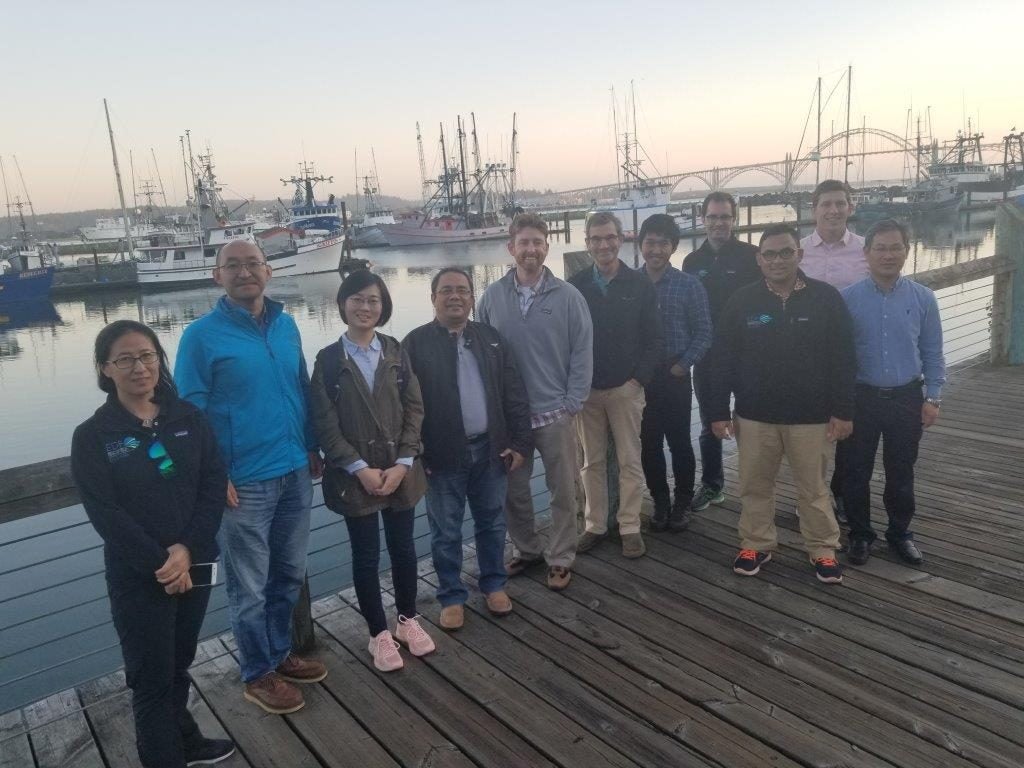By Daniel Willard and Shems Jud
 This August, a group of Indonesian, Chinese and Japanese scientists and policy professionals joined EDF to visit some of our long-time partners — fishermen, scientists and resource managers — in Oregon and Washington.
This August, a group of Indonesian, Chinese and Japanese scientists and policy professionals joined EDF to visit some of our long-time partners — fishermen, scientists and resource managers — in Oregon and Washington.
Our intent was to enhance the exchange of fisheries management experiences between the U.S. and important fishing nations in the Asia-Pacific region and contribute to a growing learning network among governments, scientists, NGOs and fishing communities.
Past challenges
Two decades ago, the U.S. West Coast groundfish fishery was declared a federal disaster. Several long-lived, slow-growing rockfish and other species had been severely overfished and stocks were expected to take decades to recover. Too much fishing capacity, a belief that fish stocks were nearly inexhaustible, and poor understanding of the biology of many of the stocks were chief culprits in this decline.
Today, things look radically different. All formerly overfished stocks have recovered, wasted bycatch has been reduced by roughly 75%, and scientists have developed new survey techniques to better understand the stocks. Fishers have been at the forefront of developing electronic monitoring (EM) and a variety of other innovations to fish more sustainably and profitably. The turn-around in West Coast fisheries is a remarkable conservation success, made possible through a combination of improved science, strong catch limits and accountability to those limits.
Improved practices
Our group learned about the roles that governments, scientists and industry play in fisheries science and management and identified several areas of mutual interest. Similar to a situation now facing fishery policymakers in Japan and some regions of China, U.S. regulators have been required by law to set and enforce scientifically determined catch limits for all federally-managed species. This contributes to significant monitoring challenges across a variety of fisheries. NOAA Fisheries leaders shared that, despite eventual success developing science-based catch limits for all managed stocks, several challenges remain — in particular, how to account for ecosystem interactions and environmental fluctuations.
 The high cost of employing fishery observers, required to monitor catch on all trips, motivated the fishing industry to test new camera EM systems as a cost-effective catch monitoring alternative. The Midwater Trawlers Cooperative described the important role industry has played to develop and expand EM. Today, EM is used by roughly half of the West Coast groundfish fleet — at significant cost savings — and it continues to provide important information to resource managers about the conservation status of scarce stocks. Our Chinese fishery partners who are exploring potential EM technologies in crab and tuna fisheries, among others, found this particularly helpful. Through our study tour, we demonstrated the importance of collecting fishery data from different sources to serve a variety of fishery and management goals.
The high cost of employing fishery observers, required to monitor catch on all trips, motivated the fishing industry to test new camera EM systems as a cost-effective catch monitoring alternative. The Midwater Trawlers Cooperative described the important role industry has played to develop and expand EM. Today, EM is used by roughly half of the West Coast groundfish fleet — at significant cost savings — and it continues to provide important information to resource managers about the conservation status of scarce stocks. Our Chinese fishery partners who are exploring potential EM technologies in crab and tuna fisheries, among others, found this particularly helpful. Through our study tour, we demonstrated the importance of collecting fishery data from different sources to serve a variety of fishery and management goals.
Lessons from local fishing communities
We also learned about some relatively simple but effective technologies used by the Quinault Indian Nation. The Quinault are using radio frequency identification, or RFID, chips to minimize crab pot theft and ensure that their fishing vessels retrieve only their own crab traps. Each trap has a coin-sized RFID chip embedded in its marker buoy. The chips are scanned on deck when traps are retrieved, and on-board cameras verify that all traps are being scanned appropriately. In addition to preventing gear theft, this gives Quinault scientists new information on the abundance and spatial distribution of crabs. This model resonated with our Asia-Pacific partners — in particular, fishery professionals in China currently exploring how to count crab catch and those in Indonesia working with fishers and communities to develop local solutions for small-scale fisheries.
Global opportunities
Despite fishery characteristics and management institutions that seem radically different on either end of the ocean — as well as language and cultural barriers that can stifle exchange — we find we have more in common with our international partners than not. Like the U.S. West Coast, Asia-Pacific nations are facing challenges of complex multispecies fishery ecosystems, new legal requirements, and industry and fishing communities with deep connections to the ocean that are struggling to thrive. The U.S. West Coast fishery has emerged as a model for what can be done with collaboration and sharing of best practices.
Our partners from China, Indonesia and Japan identified many possibilities for their own work, reinforcing the need to work together to adapt successful models to their own local conditions and available resources. Opportunities like these, where seemingly disparate fishery stakeholders discover the many challenges, goals and even fish stocks they share, are key to enhancing international collaboration and promoting global ocean sustainability.









